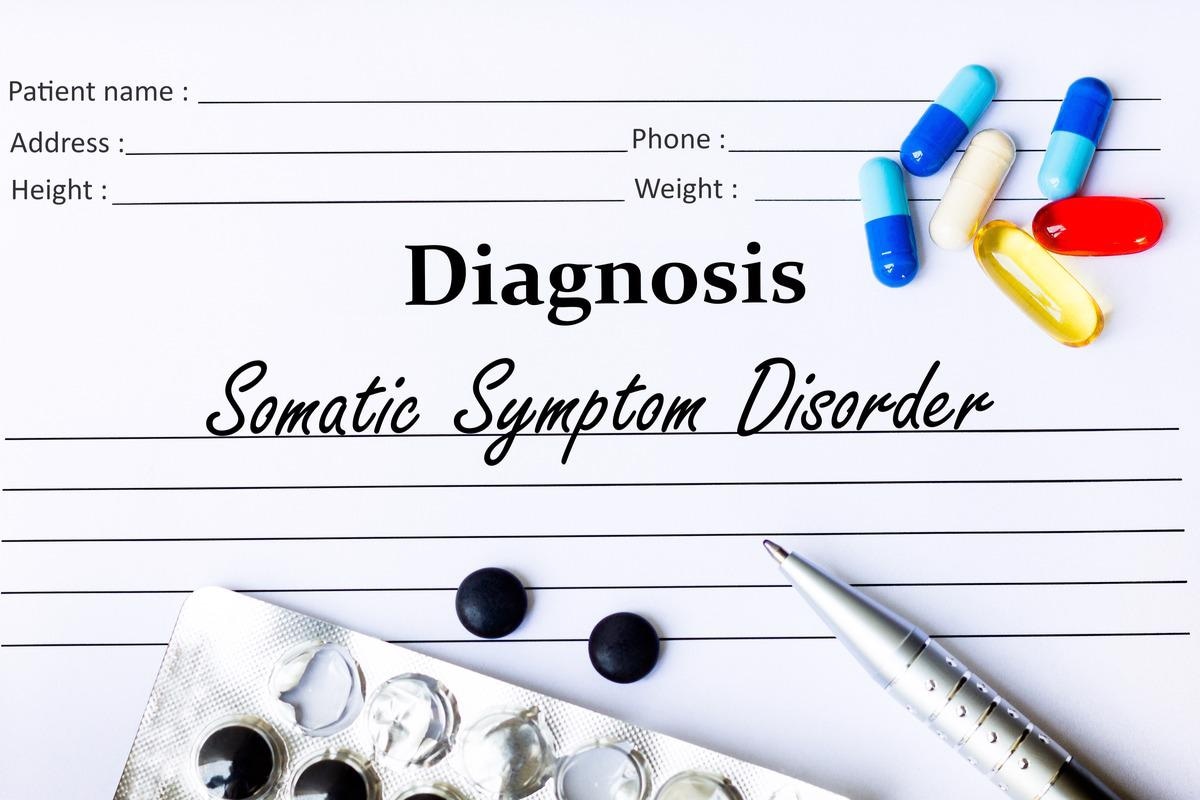Introduction
Definition in the DSM-5
Diagnostic Criteria
Epidemiology
Etiology
Pathophysiology
Treatment and Prognosis
References
Further Reading
Somatic symptom disorder is defined as mental health disorders that are characterized by prominent perceived somatic symptoms which result in distress and impairment to the individual.
 Image Credit: Marcelo Ricardo Daros/Shutterstock
Image Credit: Marcelo Ricardo Daros/Shutterstock
Definition in the DSM-5
The Diagnostic and Statistical Manual of Mental Disorders, 5th Edition (DSM-5) replaced the previous definition of somatic symptom disorders with a single diagnosis of somatic symptom disorder as well as introduced a new diagnosis of illness anxiety disorder. Previously, the DSM-IV SUB-specified somatization disorder, hypochondriasis, pain disorder, and undifferentiated somatoform disorder.
As defined in the DSM-5, semantic symptom disorder is excessive anxiety and preoccupation with more than one unexplained symptom. Its characteristics include somatic symptoms, which are related to the body and distinct from the mind, catastrophizing cognitive style, anxiety related to health, and hyperbolic responses to somatic dysfunction or discomfort.
Diagnostic Criteria
Since the revision to the DSM, two major changes have occurred relative to the previous DSM; the first is dropping the requirement that the somatic symptoms be organically unexplained, and the second is the need for certain psychobehavioral features to be demonstrated. Therefore, the diagnostic criteria for somatic symptom disorder must be present:
- One or more somatic symptoms that result in significant disruption/cause distress
- One or more excessive feelings, thoughts, and/or behaviors related to the following: (i) disproportionate and consistent thoughts about symptom severity; (ii) persistent levels of anxiety about health or symptoms; and (iii) dedicating large/debilitating amounts of time to thinking about these symptoms or health concerns
- The state of being symptomatic persists and lasts more than six months, though any one of the symptoms exhibited need not be continuously present
With regards to the severity of somatic symptom disorder, severity is defined as when two or more of the psychobehavioral symptoms are fulfilled, and there are multiple somatic complaints; moderate when two or more psychobehavioral symptoms only are fulfilled and mild when only one psychobehavioural symptom is fulfilled.
Those that suffer from somatic symptom disorder typically present in the primary care setting as opposed to a secondary care physician such as a psychiatrist or other mental health professional. Individuals that suffer from somatic symptom disorder typically experience difficulty accepting that their concerns about their symptoms are hyperbolic. The anxiety surrounding their symptoms will persist in instances when it has been evidenced to them that they do not have a serious condition.
Epidemiology
The epidemiology of somatic symptom disorder is not reliable. However, reasonable assumption dictates that the rate of patients with somatic symptom disorder is greater in the population as well as in the primary, specialist, and mental healthcare realms relative to the rates for more narrowly defined multi-symptomatic somatoform subcategorizations.
There is a persistent under-recognition of the problem of patients who present with persistent physical symptoms at large. Therefore, positive psychobehavioral features in somatic symptom disorder are necessary to prevent widespread and unspecific diagnoses.
Despite this, the prevalence of somatic symptom disorder has been estimated to be between 5% and 7% of the general population, occurring with a higher rate in females, at a female to male ratio of 10:1. Somatic symptom disorder may occur in childhood, adolescence, or adulthood. When patient populations are further subcategorized, those who have functional disorders, such as fibromyalgia, chronic fatigue syndrome, and irritable bowel syndrome, exhibit higher prevalence rates. Moreover, prevalence rises to ~ 17% of the primary care population.
 Image Credit: GoodStudio/Shutterstock
Image Credit: GoodStudio/Shutterstock
Etiology
Somatic symptom disorder arises from increased awareness of bodily sensations, with a psychological inclination to interpret these experiences as an indication of a medical problem. The exact mechanism of somatic symptom disorder is unclear, however, studies have investigated risk factors that may predispose an individual to the development of somatic symptom disorder. These include childhood neglect, sexual abuse, chaotic lifestyle, and historical evidence of alcohol and substance abuse.
There is also a correlation between severe somatization with type two personality disorders, in particular, those who have paranoid, self-defeating, and obsessive-compulsive disorders.
There are also several psychosocial stresses which can exacerbate the manifestation of thematic symptom disorder which include impaired occupational function, and unemployment.

 Read Next: What is Health Anxiety Disorder?
Read Next: What is Health Anxiety Disorder?
Pathophysiology
The pathophysiology of somatic symptom disorder is not currently known. However, several physiological mechanisms can explain feelings of anxiety and worry. This includes autonomic arousal from norandrogenic endogenous compounds which results in increased gastric motility, increased sensitivity and arousal, tachycardia, muscle tension, and muscular pain resulting from muscular hyperactivity in patients.
It is also believed that there is a genetic component to psychosomatic disorder; a study of mono and dizygotic twins revealed that the genetic contribution to the disorder was 7% to 21%, and the remainder could be attributed to external, environmental factors.
Treatment and Prognosis
The main aim of treatment for somatic symptom disorder is to help patients cope with their symptoms which predominantly include health anxiety and subsequent maladaptive behaviors. Treatment is centered around managing the response to perceived symptoms, rather than eliminating the symptoms themselves. Due to the psychological manifestation of the disorder, physicians must be cautious when explaining that patients' physical symptoms are exacerbated by anxiety or hyperbolic emotional responses, as patients can be resistant to this suggestion.
Instead, primary care providers are advised to reinforce to patients that their symptoms are not indicative of a disabling, or life-threatening medical condition. In addition, any diagnostic procedures or surgical treatment are not recommended; as are sedative medications such as narcotic analgesics and benzodiazepine.
Cognitive-behavioral therapy has been demonstrated to produce significant improvements in patient-reported measures of function and somatic symptom perception. In addition, cognitive-behavioral therapy can decrease health costs and reduce depressive symptoms in patients.
Pharmacological approaches are cautioned against, however, they may be used on a limited basis. These include antidepressants to treat any psychiatric comorbidities such as obsessive-compulsive disorder, depressive symptoms, and anxiety. In particular, selective serotonin reuptake inhibitors (SSRIs) and serotonin-norepinephrine reuptake (SNRIs) inhibitors are efficacious, demonstrating an improvement of somatic symptom disorder relative to placebo.
Despite their efficacy, initiation of SSRIs and SNRIs is recommended to begin at the lowest dose and increase slowly to achieve the desired effect, particularly as patients are likely to have a low threshold for side effect perception, which may further exacerbate the condition by causing another source of concern.
Somatic symptom disorder - causes, symptoms, diagnosis, treatment, pathology
Results of longitudinal studies have shown that somatic symptom disorder is a chronic condition, with as much as 90% of cases persisting > 5 years. Therapeutic interventions are further demonstrated to yield only small to moderate effects according to meta-analysis and systematic reviews. As such, this chronic persistent limitation of function, as well as the psychological disability incurred as a result of their perception, result in decreased quality of life.
Ultimately, somatic symptom disorder is difficult to manage, and patients are often characterized in derogatory ways. As such, there is a need to educate and train healthcare professionals about the nature and manifestation of somatic symptom disorder, its significance on the patient's life, and how best to manage them.
Referral to a psychiatrist is highly recommended when primary healthcare professionals are presented with a patient with somatic syndrome disorder. Coordinated care between nurses, clinicians, the patient, and the patient’s family is necessary to obtain the best outcome –owing to its chronicity and associated poor quality of life.
References
- Kurlansik SL, Maffei MS. Somatic Symptom Disorder. Am Fam Physician. 2016 Jan 01;93(1):49-54.
- Kleinstäuber M, Witthöft M, Steffanowski A, et al. (2014) Pharmacological interventions for somatoform disorders in adults. Cochrane Database Syst Rev. doi: 10.1002/14651858.CD010628.pub2.
- Henningsen P. (2018) Management of somatic symptom disorder. Dialogues Clin Neurosci. doi:10.31887/DCNS.2018.20.1/phenningsen.
- Liao SC, Ma HM, Lin YL, et al. (2019) Functioning and quality of life in patients with somatic symptom disorder: The association with comorbid depression. Compr Psychiatry. doi: 10.1016/j.comppsych.2019.02.004.
- D'Souza RS, Hooten WM. Somatic Syndrome Disorders. [Updated 2021 Jul 18]. In: StatPearls [Internet]. Treasure Island (FL): StatPearls Publishing; 2021 Jan-. Available from: https://www.ncbi.nlm.nih.gov/books/NBK532253/
Further Reading